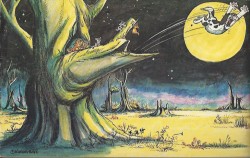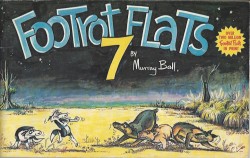

By Murray Ball (Orin Books)
ISSN: 0156-6172
Once upon a time, Britain ran an Empire, and now we’ve found a more equitable station as just one of 53(ish) independent nations in a Commonwealth. This last fortnight we’ve celebrated that with our own sporting Games, then capped that by having Britain (notional head of the Commonwealth) insult every other member of the vast panoply of nations and cultures that we’ve befriended/exploited.
Some of those nations have always been handy with comebacks, rejoinders and cartoon salvos of their own, and whilst this particular item may not have the political venom of the creator’s earlier works, it more than makes up for it by being the absolute best comedy strip the Commonwealth has ever produced (and yes, I’m even including our very own The Perishers).
New Zealand’s greatest natural wonder and National Treasure is in fact a comic strip. Footrot Flats is one of the funniest ever created, designed as a practical antidote to idealistic pastoral fantasy and bucolic self-deception and concocted in 1975 by cartoonist and comics artist Murray Ball after returning to his New Zealand homeland from an extended work tour of the UK and other, lesser, climes.
The fantastical farm feature ran for a quarter of a century, appearing in newspapers on four continents until 1994 when Ball retired it, citing reasons as varied as the death of his own dog and the state of New Zealand politics. Such a success naturally spawned a multitude of merchandising material such as strip compendia, calendars and special editions released regularly from 1978 onwards.
Once Ball officially ceased the daily feature he began periodically releasing books of all-new material until 2000, with a net yield of 27 collections of the daily strip, 8 volumes of Sunday pages dubbed “Weekendersâ€, 5 pocket books and ancillary publications such as “school kits†aimed at younger fans and their harried parents.
There was a stage musical, a theme park and in 1986 a truly superb feature-length animated film. The Dog’s Tail Tale became New Zealand’s top-grossing film (and remained so until Peter Jackson started associating with Hobbits) – track it down on video or petition the BBC to show it again – it’s been decades, for Pete’s sake…
The well-travelled, extremely gifted and deeply dedicated Mr. Ball had originally moved to England in the early 1960s, becoming a cartoonist for Punch (producing Stanley the Palaeolithic Hero and All the King’s Comrades) as well as drawing numerous strips for DC Thompson and Fleetway and even concocting a regular political satire strip in Labour Weekly.
After marrying he returned to the Old Country and resettled in 1974 – but not to retire…
Ball was busier than ever once he’d bought a small-holding on the North Island to farm in his “spare timeâ€, which inevitably led to the strip under review.
Taking the adage “write what you know†to startling, heartbreaking and occasionally stomach-turning heights, the peripatetic pencil-pusher broke most of the laws of relativity to make time for these captivatingly insane episodes concerning the highs and lows – and most frequently “absurds†– of the rural entrepreneur as experienced by the earthily metaphoric Wallace Footrot Cadwallader: a bloke never too-far removed from mud, mayhem, ferocity and frustration…
Wal is a big, bluff farmer. He likes his grub; loves his sport – Rugby, Football (the Anzac sort, not the kiddie version Yanks call Soccer) Cricket, Golf(ish) and even hang-gliding; each in its proper season and at no other, since he just wants the easiest time a farmer’s life can offer…
Wal owns a small sheep farm (the eponymous Footrot Flats) honestly described as “400 acres of swamp between Ureweras and the Seaâ€.
With his chief – and only – hand Cooch Windgrass (a latter-day Francis of Assisi), and a verbose and avuncular sheepdog, Wal enjoys being his own boss – as much as the farm cat, goats, chickens, livestock and his auntie will let him…
Other persons of perennial interest include Wal’s fierce and prickly little niece Janice – known to all as Pongo – the aforementioned Aunt Dolly (AKA the sternly staunch and starched Dolores Monrovia Godwit Footrot), smart-ass local lad Rangi Wiremu Waka Jones, Dolly’s pompous and pampered Corgi Prince Charles and Pew, a sadistic, inventive, obsessed and vengeful magpie who bears an unremitting grudge against Wal…
When not living in terror of the monumental moggy dubbed “Horseâ€, teasing the corpulent Corgi or panic-attacking himself in imagined competition with noble hunting hound Major, the Dog narrates and hosts the strip.
A cool, imaginative and overly sentimental know-all and blowhard, Dog is utterly devoted to his, for want of a better term, Master – unless there’s food about, or Jess the sheepdog bitch is in heat again. However, the biggest and most terrifying scene-stealer was that fulsome feline Horse; a monstrous and imperturbable tomcat who lords it over every living thing in the district …
One of the powerful and persistent clichés of life is that to make people laugh one truly needs to experience tragedy and, having only recently lost my own four-footed studio-mate and constant companion of 15 years, I can certainly empathise with the artist’s obvious manly distress as this otherwise magnificently hilarious collection is movingly dedicated to the uniquely charming real-world inspiration for the battered and bewhiskered juggernaut… which only makes the comedy capers contained within even more bittersweet and effective, beginning with the poem to his departed companion and the bluff, brisk photo tribute which opens proceedings…
Once again the funny businesses comes courtesy of the loquacious canine softie, taking time out from eking out his daily crusts (and oysters and biscuits and cake and lamb’s tails and scraps and chips and…) and alternately getting on with or annoying the sheep, cows, bull, goat, hogs, ducks, bugs, cats, horses and geese, as well as sucking up to the resolutely hostile wildlife and the decidedly odd humans his owner knows or is related to.
Dog – his given name is an embarrassing, closely and violently guarded secret – loves Wal but always tries to thwart him if the big bloke is trying to do unnecessarily necessary farm chores such as chopping down trees, burning out patches of scrub, culling livestock, or trying to mate with the pooch’s main rival Darlene “Cheeky†Hobson, hairdresser-in-residence of the nearest town. As is also the case with the adoring comradeship of proper blokes, Dog is never happier than when embarrassing his mate in front of others, which explains the pages extracted from Wal’s old albums, showing the man to be in various humiliating baby shots and schoolboy scrapes…
Following on is the epic adventure ‘The Invasion of the Murphy Dogs’ – barbaric hounds from a neighbouring farm only afraid of one thing…
This extra-large (262x166mm) landscape monochrome seventh volume again comes from Australian Publisher Orin Books and continues the policy of dividing the strips into approximately seasonal sequences, and after a few more all-original cartoons again opens with ‘Spring’ – the busiest season of the farmer’s year (apart from the other three) – concentrating on Pew’s first attempts at avian home-making, Dog’s libido, horny farmers and hussy-hairdressers, loopy lambs, wild pigs, killer eels and cricket, as well as an extended sequence in which Wal and the Dog become involved in the local school’s curriculum and cuisine…
Once the long hot ‘Summer’ settles in, bringing fun with chicken-shearing, busy bees, a plague of carnivorous Wekas, thistles, Horse’s softer side(!) and his war with Pongo and Aunt Dolly, Hare infestations, river-rafting, Irish Murphy’s Pigs (far worse than his dogs), Cheeky’s picnic charm-offensive and the growing closeness of Rangi and Pongo…
‘Autumn’ brings piglets, scrub-burning, the revenge of dispossessed magpies, amorous bovines, fun with artificial insemination, fence-lining and back country cattle, honey-harvesting, darts and rugby, a confused ram who’d rather pursue Dolly than associate with eager ewes and Horse’s crucial role in the war against the magpies…
As ‘Winter’ again closes in, offering floods, the mixed messy joy of lambing season, mud, mad goats, whitebait fishing and footy, Wal unwisely agrees to take a class of schoolkids and their puritanical, prudish and priggish teacher on an eye-opening nature-lesson around Footrot Flats. Touched by the painful experience, the bluff cove then volunteers to coach the school’s sports and, after much humiliation, spends the rest of the book discovering how hard – and, for observers, funny – farming in a plaster cast can be…
As you’d expect, the comedy content is utterly, absolutely top-rate and the extended role played throughout by the surly star Horse all the more poignant…
Ball – who died in 2017 – was one of those truly gifted individuals who can actually imbue a few lines on paper with the power of Shakespeare’s tragedy and the manic hilarity of jester geniuses such as Tommy Cooper or the Marx Brothers. When combined with his sharp, incisive yet warmly human writing the result was, is, and remains sheer, irresistible magic.
In the early 1990s Titan Books published British editions of the first three volumes and German, Japanese, Chinese and American translations also exist, as well as the marvellous Australian compendia reviewed here – as ever the internet is your friend (although prices for individual volumes can range from £4 to $3,000, so if ever there was an argument for a comprehensive archival re-release, sheer profit would seem to be it)…
Dry, surreal and wonderfully self-deprecating, Footrot Flats always successfully wedded together sarcasm, satire, slapstick and strikingly apt surrealism in a perfect union of pathos and down to earth (and up to your eyebrows) fun that was and still is utterly addicting, exciting and just plain wonderful.
Plant the seeds for a lifetime of laughs by harvesting this or indeed any volume and you’ll soon see a bumper crop of fun irrespective of the weather or market forces…
© 1981-1982 Murray Ball. All Rights Reserved.
